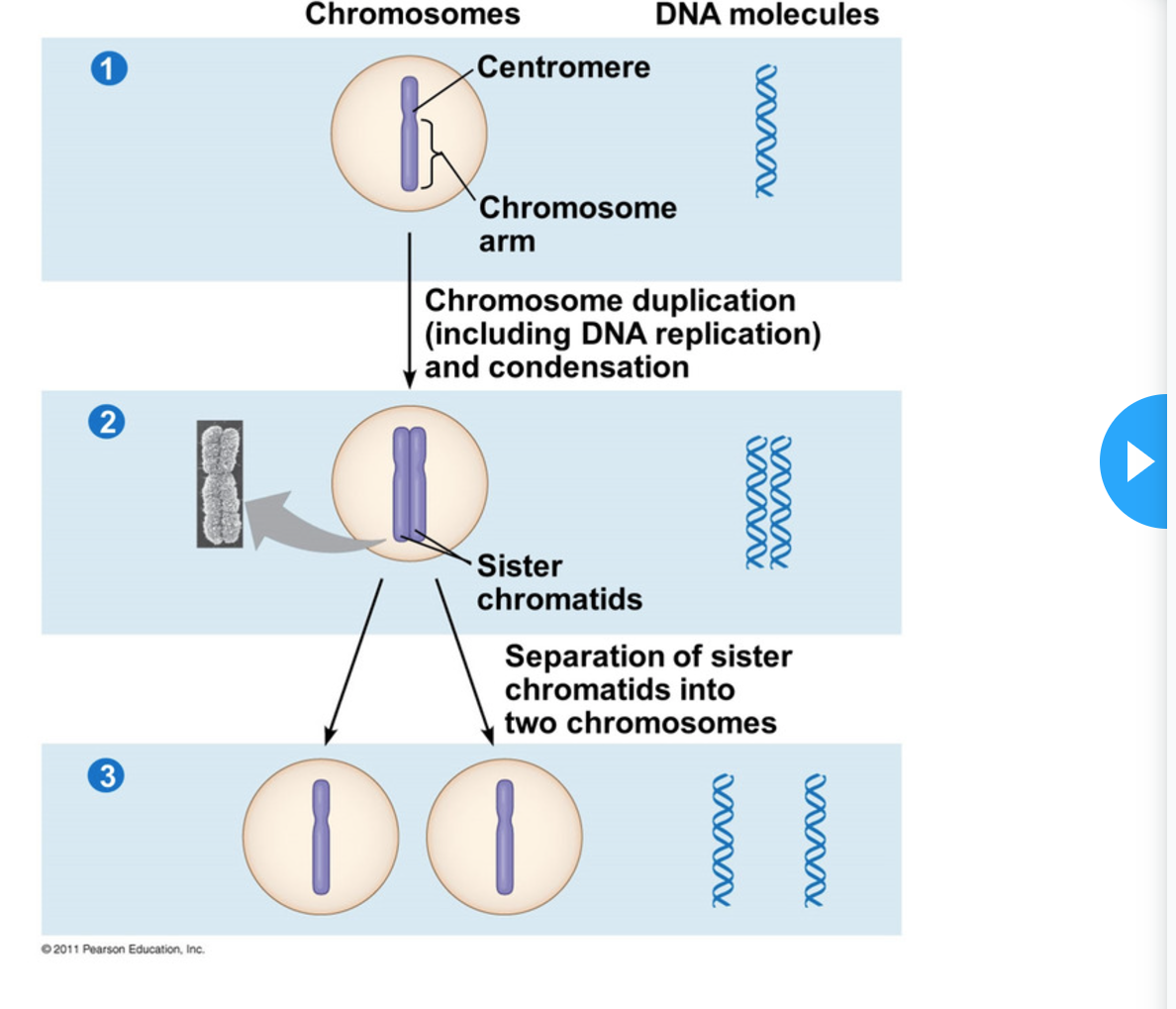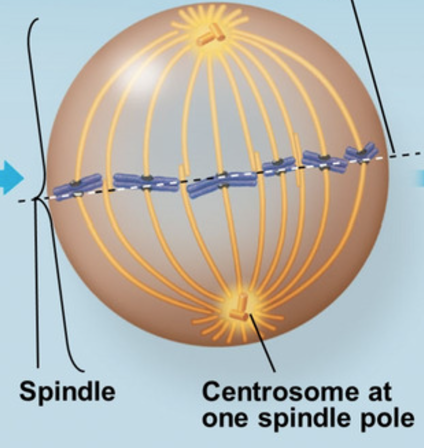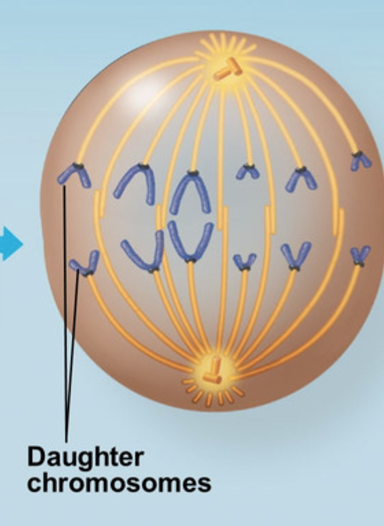chapter 12 ap bio
1/67
There's no tags or description
Looks like no tags are added yet.
Name | Mastery | Learn | Test | Matching | Spaced |
|---|
No study sessions yet.
68 Terms
cell theory
all living things made of cells, smallest unit of life are cells, cells come from pre-existing cells
cell divison
the reproduction of cells
In unicellular organisms, division of one cell reproduces what?
the entire organism
Multicellular organisms depend on cell division for:
development from a fertilized cell, growth, repair
what do most cell divisions result from?
daughter cells with identical genetic information
meiosis
a special type of division that can produce sperm and egg cells
genome
all dna in a cell. it can consist of a single dna molecule (prokaryotic cells, common in) or a number of dna moleculs (common in eukaryotic cells)
chromatin
genetic materal during interphase consists of a complex of dna and protein (histones). looks like spaghetti
what do eukaryotic chromosomes consist of?
chromatin that condenses during cell division
somatic cells (body cells)
have two sets of chromosomes and are considered diploid
gametes (reproductive cells)
have half as many chromosomes as somatic cells and are considered haploid
mitosis
the division of the genetic material in the nucleus
cytokinesis
the division of the cytoplasm
how are gametes produced
by a variation of cell division called meiosis
what does DNA do in preparation for cell division?
DNA replicates and the chromosomes condense
sister chromatids
each duplicated chromosome has two sister chromatids (joined copies of the original chromosome), which separate during cell division
centromere
the narrow “waist” of the duplicated chromosome, where the two chromatids are most closely attached
what happens to the sister chromatids during cell division?
the two sister chromatids of each duplicated chromosome separate and move into two nuclei

what happens when the two sister chromatids of each duplicated chromosome separate?
the chromatids are called chromosomes
what are inside nucleosomes?
histones
the cell cycle consists of:
interphase (cell growth and copying of chromosomes in preparation for cell division)
mitotic (M) phase (mitosis and cytokinesis)
how much time is the cell in interphase?
about 90%. but some cells can be in interphase for its entire life
what are the three subphases of interphase?
g1 phase - growth
s phase - synthesis. growth and chromosomes are duplicated
g2 phase - growth
how much of the time of the cell is spent in the m phase?
10%
what occurs during m-phase
cell division
what does the m phase include?
mitosis, cytokinesis
phases of mitsosis
prophase, metaphase, anaphase, telophase (PMAT)
what type of genetic material is present in interphase?
chromatin
is the spindle present in interphase?
no because spindles are used to move chromosomes during cell division
do animals or plants have centrioles?
animals
centrosomes vs centrioles
centrosomes - regions in plant and animal cells that make spindle
centrioles - found in the centrosome of animal cells and help make the spindle

what phase of mitosis is this?
prophase

what phase of mitosis is this?
metaphase

what phase of mitosis is this?
anaphase
![<p>what phase [of mitosis] is this</p>](https://knowt-user-attachments.s3.amazonaws.com/c8bc0c9b-e909-46a3-9ea8-63d1ada09662.png)
what phase [of mitosis] is this
telophase and cytokinesis (cytokinesis isnt apart of mitosis but)
what type of genetic material is present in mitosis
chromosomes because the genetic material must be condensed in order to divide
is the spindle present during mitosis?
yes because it is used to move the proper chromosoems to the daughter cells
what is happening during mitosis?
the division of the nucleus
how does cytokinesis occur in animal cells?
cleavage, forming a cleavage furrow
what forms during cytokinesis in plant cells?
a cell plate
how do prokaryotes reproduce?
a cell division called binary fission
what happens in binary fission?
the chromosomes replicate (beginning at the origin of replication), and the two daughter chromosomes actively move apart. the plasma membrane then pinches inward, dividing the cell into two
the frequency of cell division varies with the type of what?
the type of cell
cell cycle control system
the events of the cycle. it is regulated by both internal and external conditions. it has checkpoints where the cell cycle stops until a go-ahead signal is received
what seems to be the most important checkpoint for many cells?
G1 checkpoint
G0 phase
if the cell doesn’t receive the go-ahead signal, it will exit the cycle, switching into a nondividing state called the G0 phase
what are some factors that the cell checks to make sure it is ready for mitosis (G2 checkpoint)
cell size and the chromosomes duplicated
maturation promoting factor (MPF)
a protein kinase that regulates the transition of cells from the G2 phase to the M phase of the cell cycle
m checkpoint
occurs during metaphase. ensures all chromosomes aligned at the miotic plate are under bipolar tension. tension is sensed and initiates anaphase entry and sister chromatid separation
what checkpoint is the restriction point?
g1 checkpoint because it is a point at which the cell irreversibly commits to the cell division process
what are the two types of regulatory proteins involved in cell cycle control?
cyclins and cyclin-dependent kinases (Cdks)
why does Cdks activity fluctuate during the cell cycle
because it is controlled by cyclins, so named because their concentrations will vary with the cell cycle
what molecule varies in concentration during the cell cycle?
cyclin
what is an example of an internal signal at the checkpoints?
the kinetochores not attached to the spindle microtubules send a molecular signal that delays anaphase
growth factors
proteins released by certain cells that stimulate other cells to divide. an example of external signals
density-dependent inhibiton?
another external signal. crowded cells stop dividing once they touch
anchorage dependence
most animal cells exhibit this, which means they must be attached to a substratum in order to divide
do cancer cells exhibit density-dependent inhibition or anchorage dependnce?
NO TO BOTH
how do cancer cells ignore density-dependent inihibition?
cancer cells continue to divide and pile up, ignoring density-dependent(or contact) inhibition
how do cancer cells ignore anchorage dependence?
they lose their anchorage dependence and can travel to new locations
how come cancer cells may not need growth factors to grow and divide?
they can make their own growth factor, they can convey a growth factor’s signal without the presence of the growth factor, and they may have an abnormal cell cycle control system
transformation
a normal cell converted to a cancerous cell
cancer cells that are not eliminated by the immune system form what?
tumors
benign tumor
abnormal cells reman only at the original site
malignant tumor
they invade surrounding tissues and metastasize
why don’t cancer cells respond normally to the body’s control mechanisms?
two different gene pathways are disrupted or damaged by mutations. mutation or loss in these genes can cause cancer
protooncogenes (accelerator) (one gene pathway in the body’s control mechanisms)
make proteins that stimulate cell division, inhibit cell differentiation, and halt cell death
tumor suppressor genes (brake) (another gene pathway of the body’s control mechanisms)
make proteins that dampening or repressive the cell cycle or/and promote apoptosis